最新人教版七年级英语上学期期末总复习资料
最全面人教版七年级上册英语期末总复习归纳整理
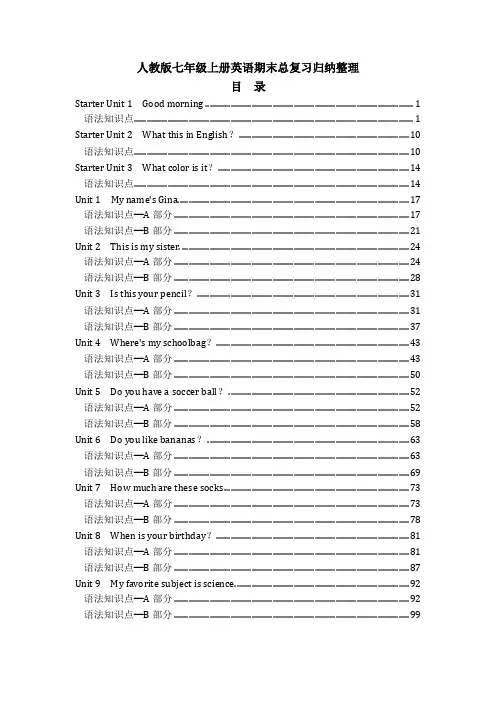
人教版七年级上册英语期末总复习归纳整理目录Starter Unit 1 Good morning (1)语法知识点 (1)Starter Unit 2 What this in English? (10)语法知识点 (10)Starter Unit 3 What color is it? (14)语法知识点 (14)Unit 1 My name's Gina (17)语法知识点━A部分 (17)语法知识点━B部分 (21)Unit 2 This is my sister. (24)语法知识点━A部分 (24)语法知识点━B部分 (28)Unit 3 Is this your pencil? (31)语法知识点━A部分 (31)语法知识点━B部分 (37)Unit 4 Where's my schoolbag? (43)语法知识点━A部分 (43)语法知识点━B部分 (50)Unit 5 Do you have a soccer ball? (52)语法知识点━A部分 (52)语法知识点━B部分 (58)Unit 6 Do you like bananas? (63)语法知识点━A部分 (63)语法知识点━B部分 (69)Unit 7 How much are these socks (73)语法知识点━A部分 (73)语法知识点━B部分 (78)Unit 8 When is your birthday? (81)语法知识点━A部分 (81)语法知识点━B部分 (87)Unit 9 My favorite subject is science (92)语法知识点━A部分 (92)语法知识点━B部分 (99)Starter Unit 1 Good morning语法知识点1、26个字母的发音、书写顺序及书写规范❶26个字母的书写规范⑴按照字母的笔顺和字母在三格中应占的位置书写。
⑵每个字母都稍向右倾斜,斜度要一致。
人教版七年级英语上册(部编2023) 期末复习提纲
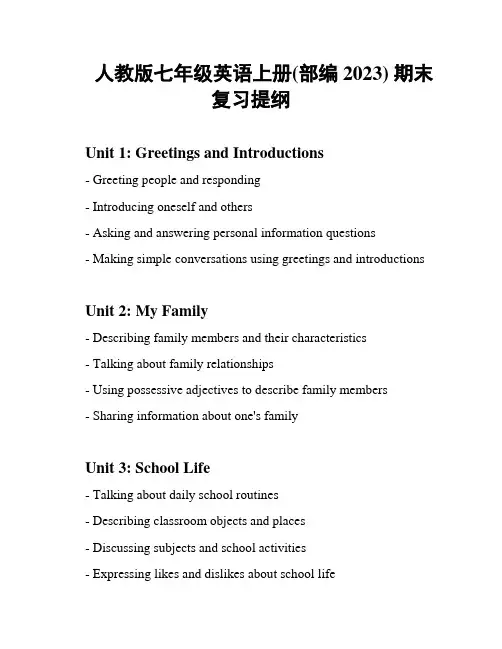
人教版七年级英语上册(部编2023) 期末复习提纲Unit 1: Greetings and Introductions- Greeting people and responding- Introducing oneself and others- Asking and answering personal information questions- Making simple conversations using greetings and introductionsUnit 2: My Family- Describing family members and their characteristics- Talking about family relationships- Using possessive adjectives to describe family members- Sharing information about one's familyUnit 3: School Life- Talking about daily school routines- Describing classroom objects and places- Discussing subjects and school activities- Expressing likes and dislikes about school lifeUnit 4: Hobbies and Interests- Talking about hobbies and interests- Describing activities related to hobbies- Expressing preferences and opinions about hobbiesUnit 5: Food and Drinks- Describing food and drinks- Talking about likes and dislikes of food- Ordering food and drinks at a restaurant- Expressing preferences for different types of foodUnit 6: Colors and Clothes- Learning different colors in English- Describing clothes and their colors- Talking about clothing preferences and styles- Discussing appropriate clothing for different occasionsUnit 7: Numbers and Telling Time- Learning and pronouncing numbers in English- Talking about dates and birthdays- Telling time and discussing daily schedules- Expressing time using both analog and digital formatsUnit 8: Daily Activities- Discussing daily activities and routines- Talking about leisure activities and free time- Using time expressions to describe daily routinesUnit 9: Places in the City- Describing different places in a city- Giving directions to navigate through a city- Talking about likes and dislikes of places- Discussing activities to do in different locationsUnit 10: Occupations and Aspirations- Learning and pronouncing different occupations- Talking about future aspirations and dreams- Describing job responsibilities and characteristics- Discussing personal interests related to future careersUnit 11: Weather and Seasons- Describing different weather conditions- Talking about seasons and their characteristics- Discussing favorite seasons and weather preferences- Expressing feelings and emotions about the weatherUnit 12: Holidays and Celebrations- Learning about different holidays and celebrations- Describing traditions and customs of specific holidays - Talking about personal experiences during holidays- Expressing wishes and greetings for different occasionsUnit 13: Daily Routines- Talking about daily activities and schedules- Using adverbs of frequency to describe routines- Discussing preferences for different activities- Expressing opinions about daily routinesUnit 14: Health and Body- Describing body parts and their functions- Discussing healthy habits and lifestyle choices- Giving advice for maintaining good healthUnit 15: Shopping- Talking about different types of shops and stores- Describing items for sale and their prices- Discussing shopping preferences and habits- Asking for help and making purchases at a storeUnit 16: Transportation- Learning and pronouncing different modes of transportation - Talking about means of transportation and their features- Describing travel experiences and preferences- Asking for transportation information and directionsUnit 17: Countries and Nationalities- Learning and pronouncing different countries and nationalities - Talking about one's own and others' nationalities- Discussing cultural characteristics and traditionsUnit 18: Daily Life in Different Countries- Learning about daily life customs in different countries- Talking about cultural differences and similarities- Discussing traditional food, clothing, and activities- Sharing personal experiences or knowledge about other countries- Talking about different types of technology and devices- Describing how technology is used in daily life- Discussing advantages and disadvantages of technology- Expressing opinions about technology and social mediaUnit 20: Review and Assessment- Reviewing key vocabulary and grammar points from previous units- Practicing listening, speaking, reading, and writing skills请根据这个提纲来复习人教版七年级英语上册的内容。
新人教版英语七年级上册期末复习资料(全)
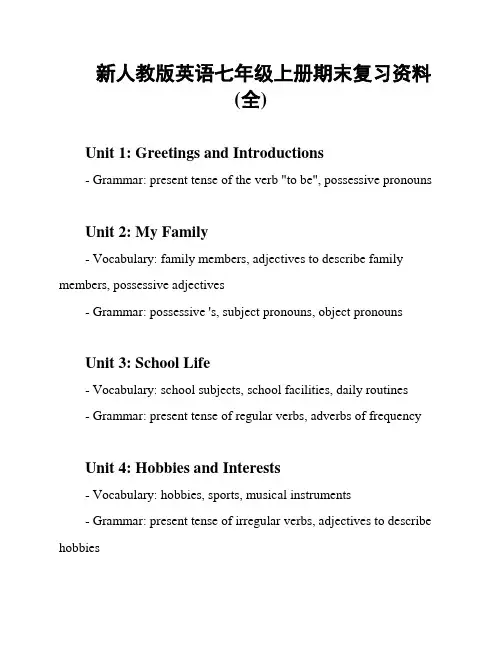
新人教版英语七年级上册期末复习资料(全)Unit 1: Greetings and Introductions- Grammar: present tense of the verb "to be", possessive pronounsUnit 2: My Family- Vocabulary: family members, adjectives to describe family members, possessive adjectives- Grammar: possessive 's, subject pronouns, object pronounsUnit 3: School Life- Vocabulary: school subjects, school facilities, daily routines- Grammar: present tense of regular verbs, adverbs of frequencyUnit 4: Hobbies and Interests- Vocabulary: hobbies, sports, musical instruments- Grammar: present tense of irregular verbs, adjectives to describe hobbiesUnit 5: Food and Drinks- Vocabulary: food, drinks, meals- Grammar: countable and uncountable nouns, quantifiers, expressing likes and dislikesUnit 6: Animals and Nature- Vocabulary: animals, adjectives to describe animals, natural environmentsUnit 7: Festivals and Celebrations- Vocabulary: festivals and celebrations around the world, traditional activities- Grammar: past tense of regular verbs, time expressionsUnit 8: Daily Routines- Vocabulary: daily activities, household chores- Grammar: present continuous tense, imperative formsUnit 9: Shopping- Vocabulary: clothing, accessories, colors, shopping phrases- Grammar: demonstrative pronouns, expressing preferencesUnit 10: Weather and Seasons- Vocabulary: weather conditions, seasons, describing the weather - Grammar: present continuous tense, location prepositionsUnit 11: Transportation- Grammar: imperative forms for instructions, giving and following directionsUnit 12: Time and Dates- Vocabulary: telling time, days of the week, months, ordinal numbers- Grammar: preposition of time, expressing dates以上是新人教版英语七年级上册的期末复习资料,希望对你的复习有所帮助。
新版人教版七年级英语上册期末知识点复习
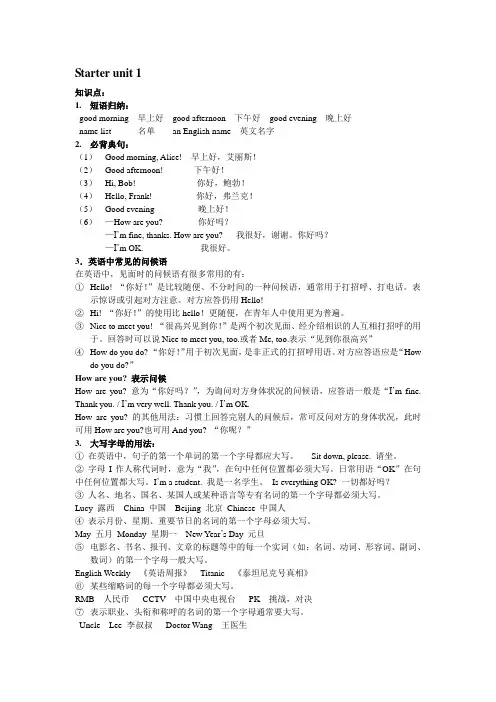
Starter unit 1知识点:1.短语归纳:good morning 早上好good afternoon 下午好good evening 晚上好name list 名单an English name 英文名字2.必背典句:(1)Good morning, Alice! 早上好,艾丽斯!(2)Good afternoon! 下午好!(3)Hi, Bob! 你好,鲍勃!(4)Hello, Frank! 你好,弗兰克!(5)Good evening 晚上好!(6)—How are you? 你好吗?—I’m fine, thanks. How are you? 我很好,谢谢。
你好吗?—I’m OK. 我很好。
3.英语中常见的问候语在英语中,见面时的问候语有很多常用的有:①Hello! “你好!”是比较随便、不分时间的一种问候语,通常用于打招呼、打电话。
表示惊讶或引起对方注意。
对方应答仍用Hello!②Hi! “你好!”的使用比hello!更随便,在青年人中使用更为普遍。
③Nice to meet you! “很高兴见到你!”是两个初次见面、经介绍相识的人互相打招呼的用于。
回答时可以说Nice to meet you, too.或者Me, too.表示“见到你很高兴”④How do you do? “你好!”用于初次见面,是非正式的打招呼用语。
对方应答语应是“Howdo you do?”How are you? 表示问候How are you? 意为“你好吗?”,为询问对方身体状况的问候语,应答语一般是“I’m fine. Thank you. / I’m very well. Thank you. / I’m OK.How are you? 的其他用法:习惯上回答完别人的问候后,常可反问对方的身体状况,此时可用How are you?也可用And you? “你呢?”3.大写字母的用法:①在英语中,句子的第一个单词的第一个字母都应大写。
2023-2024学年人教版七年级英语上册期末语法知识总复习
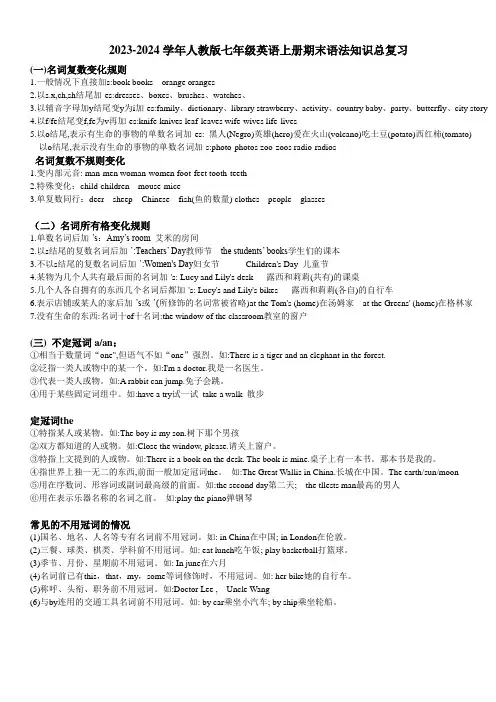
2023-2024学年人教版七年级英语上册期末语法知识总复习(一)名词复数变化规则1.一般情况下直接加s:book books orange oranges2.以s.x,ch,sh结尾加-es:dresses、boxes、brushes、watches、3.以辅音字母加y结尾变y为i加-es:family、dictionary、library strawberry、activity、country baby、party、butterfly、city story4.以f/fe结尾变f,fe为v再加-es:knife-knives leaf-leaves wife-wives life-lives5.以o结尾,表示有生命的事物的单数名词加-es: 黑人(Negro)英雄(hero)爱在火山(volcano)吃土豆(potato)西红柿(tomato)以o结尾,表示没有生命的事物的单数名词加-s:photo-photos zoo-zoos radio-radios名词复数不规则变化1.变内部元音: man-men woman-women foot-feet tooth-teeth2.特殊变化:child-children mouse-mice3.单复数同行:deer sheep Chinese fish(鱼的数量) clothes people glasses(二)名词所有格变化规则1.单数名词后加-’s:Amy’s room 艾米的房间2.以s结尾的复数名词后加-’:Teachers’ Day教师节the students’ books学生们的课本3.不以s结尾的复数名词后加-’:Women's Day妇女节Children's Day 儿童节4.某物为几个人共有最后面的名词加-'s: Lucy and Lily's desk 露西和莉莉(共有)的课桌5.几个人各自拥有的东西几个名词后都加-'s: Lucy's and Lily's bikes 露西和莉莉(各自)的自行车6.表示店铺或某人的家后加-’s或-’(所修饰的名词常被省略)at the Tom's (home)在汤姆家at the Greens' (home)在格林家7.没有生命的东西:名词十of十名词:the window of the classroom教室的窗户(三) 不定冠词a/an:①相当于数量词“one",但语气不如“one”强烈。
人教版七年级上英语期末总复习必备资料.docx
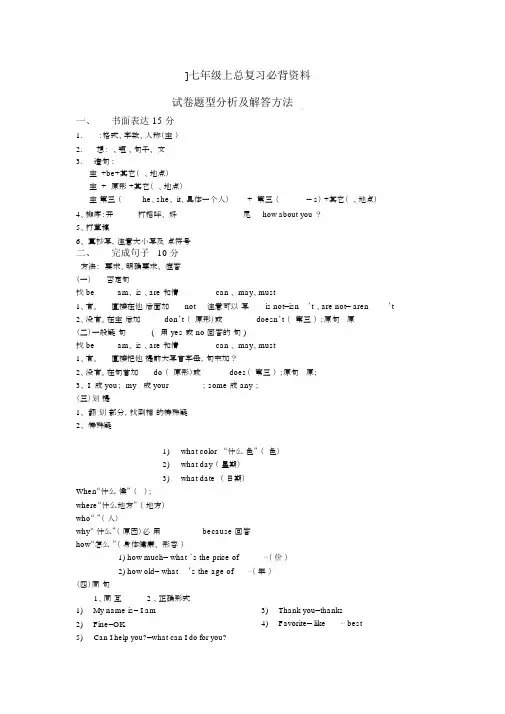
]七年级上总复习必背资料试卷题型分析及解答方法一、书面表达 15 分1.:格式、字数、人称(主)2.想:、短、句子、文3.造句 :主 +be+其它(、地点)主 +原形 +其它(、地点)主第三(he、she、 it、具体一个人)+第三(—s)+其它(、地点)4、排序:开打招呼、好尾how about you ?5、打草稿6、真抄写,注意大小写及点符号二、完成句子10 分方法:要求、明确要求、症答(一)否定句找 be am、 is 、are 和情can 、 may、must1、有。
直接在他后面加not注意可以写is not=isn’t、are not= aren’t2、没有。
在主后加don’t (原形)或doesn’t (第三);原句原(二)一般疑句(用yes或no回答的句)找 be am、 is 、are 和情can 、 may、must1、有。
直接把他提前大写首字母,句末加?2、没有。
在句首加do (原形)或does(第三);原句原;3、 I 成 you; my 成 your;some成any;(三)划提1、翻划部分,找到相的特殊疑2、特殊疑1)what color “什么色”(色)2)what day (星期)3)what date (日期)When“什么候”();where“什么地方”(地方)who“ ”(人)why“ 什么”(原因)必用because 回答how“怎么”(身体健康、形容)1) how much= what ’s the price of2) how old= what’s the age of⋯(价)⋯(年)(四)同句1、同互 2 、正确形式1) My name is= I am2) Fine=OK 3) Thank you=thanks4) Favorite= like⋯best5)Can I help you?=what can I do for you?6)how much= what ’s the price of⋯7)how old= what ’s the age of⋯8)how about=what about9)Thanks for=Thank you for(五)翻1中英2正确形式(六)肯定回答---yes否定回答---- no句首什么,就用什么回答(七)句子复数t his-these;that-those;is-are;it-they三、口运用( 10 分)翻方框的句子--- 想情景 --- 逐句翻,先易后,瞻前后--- 代入四、(一)找短1、后接 do 的:Let; let’s do助do、 does 、don’t 、doesn’t后面2、后接 to do的:want3、后接 doing 的: like;介;thanks for=thank you for ;what about=how about(二)看1、冠a(音前)an(元音前)an ID card;an“H”the(序数、第二次出)2、 beam( I )、is( 数 ) 、are ( you、复数)方法: I 是 am;you 是 are ;数 is ;复数 are ;this ( that )is ;these ( those )are4、名可数(不能独使用:前面加a、 an 或后面加 s)tomato-tomatoes; watch-watches ;不可数(独使用)5、人称代第第二第三人称数第一第二第三分及用法一人称人称人称人称人复数复数复数称主格 ( 主、句首 )I you he she It we you they 格(、,介后)Me you Him her It us you them 形容性(名前)My your His her Its our your their 物主名性Min your His hers Its ours yours theirs 物主代(独使用)e s6、数基数(表示数量)one、 two 、 three 、 four 、 twelve序数(表示序)前面要用the: first 、 second 、 third、fourth、 twelfth7、 what’s this/that?------It ’s +a/an+ 名what’s color----It ’s + 色8、中国人的名字 =last name(姓氏) +first name(名字)外国人的名字 = first name(名字) + last name(姓氏)Mr / Miss/ Ms等尊称要放在last name (姓氏)前9、 in English用英10、call me at 55555; call⋯at+ 号“ 某人打”11、我和 Jenny----Jenny and I12、某人的 Bob’ s ;Teachers’ Day;Bob’s and Mike ’s( 分有 ) ---Bob and Mike ’s( 共有 )13、On the wall(在上表面) ----- in the wall(在上里面)14、On the floor在地上15、Many 多(可数名复数)--- much多(不可数名)16、On-under-in17、Bring来 ---- take去; take to到某地18、Play+ 球、游、运Play the +器Play with和某人玩19、every day每天20、for breakfast; for lunch;for dinner21、in a very good price以非常惠的价格22、come to 来到某地; come to my party; come to my school23、go shopping物24、sell to出— buy25、in (早、中、晚、月份、年份): in September ; in the morningon(日期、星期、日): on September 6th; on Sunday ; on Children ’s Day at(具体刻): at 8:0026、I ’ll take it我要下它27、How are you ? --Fine , thanks28、Nice to meet you---- Nice to meet you, too29、Here is your pen---Thank you=Thanks30、Is this/that⋯ ?必用 it回答 Yes, it is/No, it isn’t31、 A photo of my family=my family photo我的一全家福(三)代入法(四)排除法四、完形填空1.通全文、了解大意。
新版人教版七年级英语上册期末知识点复习
新版人教版七年级英语上册期末知识点复习Starter Unit 1Knowledge Points:1.Phrase Summary:Good morning - Good morningGood afternoon - Good afternoonGood evening - Good eveningName list - List of namesAn English name - An English name2.Must-know XXX:1) Good morning。
Alice。
- Good morning。
Alice!2) Good afternoon。
- Good afternoon!3) Hi。
Bob。
- Hi。
Bob!4) Hello。
Frank。
- Hello。
Frank!5) Good evening - Good evening6) - How are you。
- How are you?I'm fine。
thanks。
How are you。
- I'm OK.mon XXX:① Hello。
"Hello!" XXX is usually used to say hello or answer the phone。
It can also be used to express surprise or get someone's n。
The response is still "Hello!"② Hi。
"Hello!" is used more casually and is more common than "Hello!"③ Nice to meet you。
"Nice to meet you!" is used when two people meet for the first time。
(完整word版)人教版七年级上册英语期末复习资料.docx
七年级英语上册复习资料Starter Units 1-3重点:morning afternoon how finename list what maporange jacket key quiltpen ruler spell pleasecolor red yellow greenblue black white the重点短:早上好下午好晚上好你Me too.You too.in English black and white重点句型:1、 Good morning , Alice!2、Hello , Frank !Good morning , Cindy!Hi ,Cindy ! How are you ?3、 Good evening ,Alice !I ’m fine , thanks .Good afternoon ,Eric!4、 What ’s this in English? 5 、What ’s this ?It ’s a key .It ’s V.Spell it ,please.What color is it ?K-E-Y.It ’s red .重点法:1、五个元音字母及其在开音和音中的音;2、指示代 (this that these those)的用法与区。
Unit 1My name’s Gina.重点:clock nice meet questionanswer look first lastboy girl telephone phonecard familyNumbers 0-9.重点短:telephone number phone numberfirst name last name family name身份What ’s =I ’m=name’s =重点句型:1、 What ’s your name ?2、 What ’s his name?My name ’s Jenny . / I’m Jenny.His name is ⋯ / He’s ⋯Nice to meet you!What ’s her name?Nice to meet you , too!Her name is⋯ / She’s ⋯3、 What ’s her telephone number?4、 What ’s his first name?Her telephone number is ⋯ / It ’s ⋯What’s his family/last name?1重点语法:1、英文名 Tony Brown中 Tony 为 first name(名), Brown 为 last name 或 family name (姓)。
人教版七年级英语上册期末总复习详细
名词性 物主代词
mine ours yours yours his hers 无 theirs
专题【归强类化复训习练一】
Ⅰ. 用所给词的适当形式填空
1.____S_h_e___ (she) is a girl. __H__e_r_(she) name is Lucy. 2.__M__y_(I) name is Kate. What's___y_o_u_r__(you) name? 3.What is___h__is__(he) telephone number? 4.Are__y_o_u_(your) Miss Smith? 5.___I_ts__(it) name is Mimi.
专题归类复习二 考点3 方位介词的用法 【要点解读】 表示人或物在某地要借助方位介词。方位介词通常不单独
作句子的成分,与后面的名词一起构成介词短语充当一定的句 子成分。
1.on意为“在……上面(与物体的表面有接触)”。 2.under意为“在……下面(指在物体的垂直下方,两者 不接触)”。 3.in意为“在……里面(指在物体的内部)”。 其结构为:方位 介词+the/a/an/物主代词等+物品名词
物主代词分形容词性物主代词和名词性物主代词。形容词性物
主代词在句中只用作定语,相当于一个形容词,不能单独使用;名
词性物主代词则不能用作定语,相当于一个名词词组,可以单独使
用。
Her is… He name is…
Mine book is …
✓ She is.. ✓ His name is…
✓ My book is…
考点2 名词复数
【要点解读】
英语中,名词分为可数名词和不可数名词。可数名词有单复数两种
最新人教版七年级(初一)上册英语总复习资料
最新人教版七年级(初一)上册英语总复习资料单元总复Unit 1:你叫什么名字?- 本单元主要研究问候语、自我介绍及询问对方姓名等。
- 要点总结:掌握问候语、介绍自己及询问对方姓名的表达方式,能够熟练运用所学表达方式进行日常交际。
Unit 2:你喜欢什么颜色?- 本单元主要研究有关颜色、物品、人物等方面的表述方式。
- 要点总结:掌握描述物品、人物、颜色等方面的常用句型,能够正确、流利地表达与描述这些内容。
Unit 3:他穿什么衣服?- 本单元主要研究服装及气候方面的相关表达方式。
- 要点总结:掌握描述穿衣、气候等方面的基础语句,能够灵活运用所学内容进行简单交际。
Unit 4:她喜欢听音乐吗?- 本单元主要研究家庭、音乐及娱乐方面的相关表达方式。
- 要点总结:掌握询问个人爱好及描述家庭成员的表达方式,能够较为流利地表达这些内容。
Unit 5:你们学校的图书馆怎么样?- 本单元主要研究学校设施及活动的相关表达方式。
- 要点总结:掌握询问学校设施和活动的表达方式,能够简单描述所属学校相关环境。
Unit 6:他怎么上学?- 本单元主要研究交通工具及出行方式的相关表达方式。
- 要点总结:掌握询问及描述交通工具和出行方式的基础表达方式,能够应对日常生活相关情境。
语法重点- 现在进行时:表示现在正进行着的动作或状态,形式为“be+现在分词”。
- 物主代词:表示物主关系的代词,包括my、your、his、her、its、our、their。
- 人称代词:表示人称关系的代词,包括I、you、he、she、it、we、they。
词汇总结- 掌握1000左右的常用英语词汇,包括动词、名词、形容词等方面。
- 建议根据自己的研究进度制定相应的词汇研究计划。
阅读材料- 阅读理解:读懂英文短文,抓住文章的主旨和信息细节。
- 书面表达:能够用英语进行简短书面表达。
口语练- 提高口语速度和表达流利度,建议多进行和他人的英语对话练,或参加英语角等相关活动。
- 1、下载文档前请自行甄别文档内容的完整性,平台不提供额外的编辑、内容补充、找答案等附加服务。
- 2、"仅部分预览"的文档,不可在线预览部分如存在完整性等问题,可反馈申请退款(可完整预览的文档不适用该条件!)。
- 3、如文档侵犯您的权益,请联系客服反馈,我们会尽快为您处理(人工客服工作时间:9:00-18:30)。
最新人教版七年级英语上学期期末总复习资料预备单元1. 重点句型.1. ----How are you ?---- I’m fine, thank you. \ thanks. How are you? \ And you?----I’m OK, thank you.\ thanks. ----- Fine, thank you.\thanks.2. -----What’s this \ that in English? ----- It’s a\ an …3. ----What’s this \ that? ------It’s a \an…4. Spell it, please.=How do you spell it,please?5.. --- What color is it? ---- It’s + 表示颜色的单词2.缩略词.1.USA 2. CD 3. BBC4. NBATV6. UFO7. kgUnit 11. 重点词短语1. first name = given name2. last name = family name3. phone number = telephone number4. ID card5. school ID card2. 重点句型.1. ----What’s your name? ---- My name’s +名字./ I’m +名字./ 直接回答名字.2.----What’s her name? -----Her name’s…3.------What’s his name? -----His name’s…4. --What’s your telephone number? ----It’s + 电话号码. \ My telephone number is + 号码5.---What’s her\ his telephone number? ----Her \His telephone number is+号码6.---Nice to meet you! -----Nice to meet you, too.3.知识点1. 中英姓名的用法与区别:中国人,姓在前名在后。
英美国家则相反,名在前姓在后。
所以名是first name=given name,姓family name= last name. (Jim Green) (Li Xiao hong)2.be 动词用法口决:我(I)用am,你(you)用are,is连着他她它(he\she\it),单数主语用(is),复数主语全用(are).3.人称代词及用法. (请写出)单数:人称主格宾格形容词性物主代词名词性物主代词第一人称I (我) me(我) my(我的)第二人称you(你)you(你)your(你的)第三人称he(他) him(他) his(他的)She(她)her(她)her(她的)it(它)it(它)its(它的)复数:人称主格宾格形容词性物主代词名词性物主代词第一人称we(我们)us(我们)our(我们的)第二人称you(你们) you(你们) your (你们的)第三人称they(他她它)们them(他她它)们 their(他她它)们的c.用法:动前主格动后宾,名前形容介后宾。
(动词前用主格,动词后用宾格;名词前用形容词性物主代词,介词后用宾格。
)d.不定冠词a与an的用法: 都表示“一个,一张,一件”等义,一般用于单数名词前。
a用于辅音音素开头的单词前,an用于元音音素开头的单词前。
an English book \ an UFO \ an eraser \ an orangean apple \ an egg \ an ID card \ a green appleI.选择题:()1. Can you spell____ name?A. youB. itC. yourD. me()2. -----Are you Bill?---- ______________.A. Yes,I’m.B. No, I am.C. No, I’m not.D. Yes, I’m not.()3. There's ____ "u" and _____ "s" in the word "us".A. a, anB.an, aC. a, aD. an, an()4. This______ my sister and those ______my parents.A. is, isB. is, are C, are, is D. are, are()5.. Miss Zhou is ________ English teacher. ________ is a good teacher.A. our, HerB. my, HeC. a, SheD. an, She( ) 6.—Your English is very good. —_________.A. No , it isn’t.B. Yes , it is.C. Thank you.D. No .()7.The man Nick Hand. ____ is his family name, and___ is his given name.A. Nick , Hand B . Hand, Nick C. Hand, Hand D. Nick, Nick( ) 8.Lucy and Tony___ my good friends.A. amB. isC. areD. be( ) 9. ----What’s that in English?-----_______ID card.A. This is aB.That’s anC. It’s aD. It’s an( ) 10.My name___ Alice ,__name is Tony .A. am ,herB. is , hisC. is, herD. am , hisII.用所给词的适当形式填空.1.What color_____ (be)your quilt?2. This boy and his friend______(be) students.3. _____are good students. I like____ very much. (they)4. Mary is her _____(one) name.Unit21.重点词组及同义词、同义短语.1. parent =father or mother2. parents= father and mother3. grandparent= grandfather or grandmother4.grandparents= grandfather and grandfather5.cous in= my uncle’s \ aunt’s son \ daughter6. uncle = my father’s \ mother’s brother7. aunt = my father’s \ mother’s sister8. picture = photo9. pen friend 10. family photo11. thanks for… 12. a photo of my family2. 重点句型.1. Is this your \ his \ her sister?2. Is that your \ his \ her brother?3.Are these \ those your \ his \ her sisters ?Yes, they are. \ No, they aren’t.4.Is she your sister ? ---Yes, she is. ---No, she isn’t.5. Is he your father ? ---Yes, he is. ---No, he isn’t.6. This is my cousin.That is my brother.7.These are my cousins.3.知识点1. 介绍人的句型:This is + 某人. \ These are + 某人.(指着距离较近的人进行介绍)That is + 某人. \ These are + 某人. (指着距离较远的人进行介绍)2. 对“this” /“that”直接做主语的疑问句回答时,答句的主语用“ it”.3. 对“these”/“those”作主语的疑问句回答时,答句的主语用“they”.4. Thanks for… = Thank you for…为……而感谢.5. 名词所有格:是指在某一名词后右上角打“’s”,表示“……的”这一结构形式。
有生命的名词;一般在词后加’s . 如果是以“s”或“es”结尾的只需加上’ .Jim’s book \ teachers’ pensI.选择题:()1. My uncle’s daughter is my _______ . .A. brotherB. sisterC. cousinsD. cousin ()2. ------_______ your sister? ------Yes, it is .A. Are theseB. Are thoseC. Is thatD. Is these ()3. Here is a photo_______ my father.A. atB.inC. forD. of()4. --- Hi, Jim! _______ is Tom.. He is my good friend.---Hi, Tom! Nice to meet you.A. HeB. ThatC. ThisD. It( )5.. – How do you do? -- .A. Fine, thank you.B. How do you do?C. How are you?D. Good night! ( )6. ---Is she your sister? ---Yes, ___.A.he isB. she isC. it isD. she isn’t ( )7. ---___ they her brothers ? ---No, they ___.A. Are, ar en’tB. Are, areC. Is, areD. These, aren’t ( )8.. Here ___ my family photo.A. isB. areC. amD. be( )9.. Thanks ___ your pen.A. forB. toC. atD. In( )10.Are ________ Kate’s ________?A.this, book B.that,book C.these,books D.those,book II、根据句意用所给词的适当形式填空。
